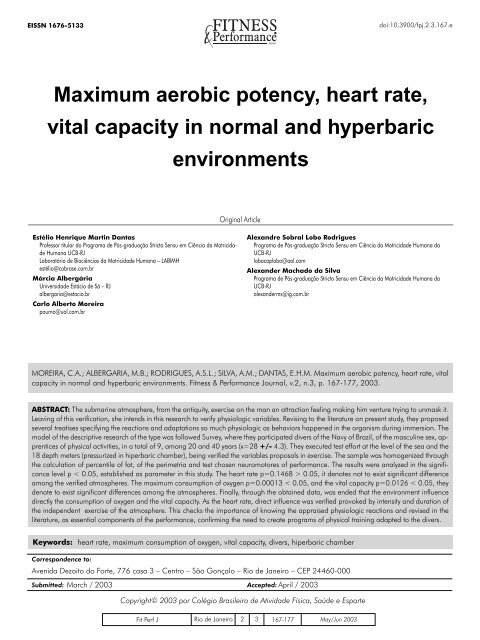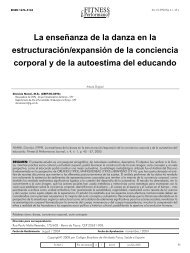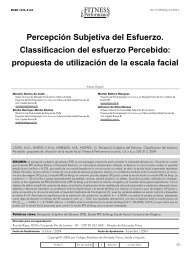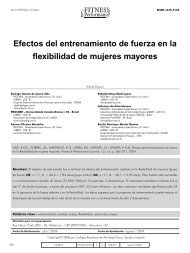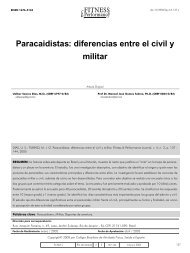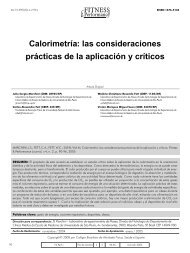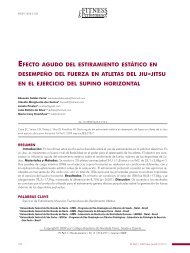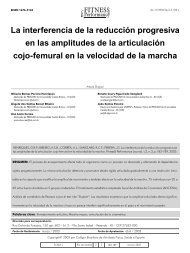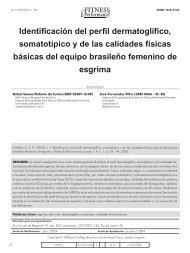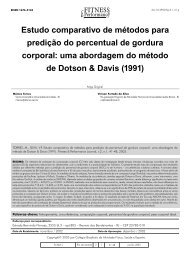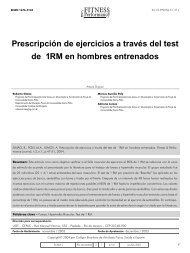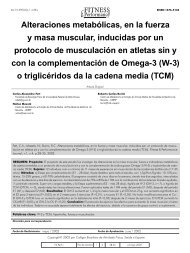Maximum aerobic potency, heart rate, vital capacity in normal and ...
Maximum aerobic potency, heart rate, vital capacity in normal and ...
Maximum aerobic potency, heart rate, vital capacity in normal and ...
Create successful ePaper yourself
Turn your PDF publications into a flip-book with our unique Google optimized e-Paper software.
EISSN 1676-5133<br />
doi:10.3900/fpj.2.3.167.e<br />
<strong>Maximum</strong> <strong>aerobic</strong> <strong>potency</strong>, <strong>heart</strong> <strong>rate</strong>,<br />
<strong>vital</strong> <strong>capacity</strong> <strong>in</strong> <strong>normal</strong> <strong>and</strong> hyperbaric<br />
environments<br />
Orig<strong>in</strong>al Article<br />
Estélio Henrique Mart<strong>in</strong> Dantas<br />
Professor titular do Programa de Pós-graduação Stricto Sensu em Ciência da Motricidade<br />
Humana UCB-RJ<br />
Laboratório de Biociências da Motricidade Humana – LABIMH<br />
estélio@cobrase.com.br<br />
Márcia Albergária<br />
Universidade Estácio de Sá – RJ<br />
albergaria@estacio.br<br />
Carlo Alberto Moreira<br />
poumo@uol.com.br<br />
Alex<strong>and</strong>re Sobral Lobo Rodrigues<br />
Programa de Pós-graduação Stricto Sensu em Ciência da Motricidade Humana da<br />
UCB-RJ<br />
lobocaplobo@aol.com<br />
Alex<strong>and</strong>er Machado da Silva<br />
Programa de Pós-graduação Stricto Sensu em Ciência da Motricidade Humana da<br />
UCB-RJ<br />
alex<strong>and</strong>erms@ig.com.br<br />
MOREIRA, C.A.; ALBERGARIA, M.B.; RODRIGUES, A.S.L.; SILVA, A.M.; DANTAS, E.H.M. <strong>Maximum</strong> <strong>aerobic</strong> <strong>potency</strong>, <strong>heart</strong> <strong>rate</strong>, <strong>vital</strong><br />
<strong>capacity</strong> <strong>in</strong> <strong>normal</strong> <strong>and</strong> hyperbaric environments. Fitness & Performance Journal, v.2, n.3, p. 167-177, 2003.<br />
ABSTRACT: The submar<strong>in</strong>e atmosphere, from the antiquity, exercise on the man an attraction feel<strong>in</strong>g mak<strong>in</strong>g him venture try<strong>in</strong>g to unmask it.<br />
Leav<strong>in</strong>g of this verifi cation, she <strong>in</strong>tends <strong>in</strong> this research to verify physiologic variables. Revis<strong>in</strong>g to the literature on present study, they proposed<br />
several treatises specify<strong>in</strong>g the reactions <strong>and</strong> adaptations so much physiologic as behaviors happened <strong>in</strong> the organism dur<strong>in</strong>g immersion. The<br />
model of the descriptive research of the type was followed Survey, where they participated divers of the Navy of Brazil, of the mascul<strong>in</strong>e sex, apprentices<br />
of physical activities, <strong>in</strong> a total of 9, among 20 <strong>and</strong> 40 years (x=28 +/- 4.3). They executed test effort at the level of the sea <strong>and</strong> the<br />
18 depth meters (pressurized <strong>in</strong> hiperbaric chamber), be<strong>in</strong>g verifi ed the variables proposals <strong>in</strong> exercise. The sample was homogenized through<br />
the calculation of percentile of fat, of the perimetria <strong>and</strong> test chosen neuromotores of performance. The results were analyzed <strong>in</strong> the signifi -<br />
cance level p < 0.05, established as parameter <strong>in</strong> this study. The <strong>heart</strong> <strong>rate</strong> p=0.1468 > 0.05, it denotes not to exist signifi cant difference<br />
among the verifi ed atmospheres. The maximum consumption of oxygen p=0.00013 < 0.05, <strong>and</strong> the <strong>vital</strong> <strong>capacity</strong> p=0.0126 < 0.05, they<br />
denote to exist signifi cant differences among the atmospheres. F<strong>in</strong>ally, through the obta<strong>in</strong>ed data, was ended that the environment <strong>in</strong>fl uence<br />
directly the consumption of oxygen <strong>and</strong> the <strong>vital</strong> <strong>capacity</strong>. As the <strong>heart</strong> <strong>rate</strong>, direct <strong>in</strong>fl uence was verifi ed provoked by <strong>in</strong>tensity <strong>and</strong> duration of<br />
the <strong>in</strong>dependent exercise of the atmosphere. This checks the importance of know<strong>in</strong>g the appraised physiologic reactions <strong>and</strong> revised <strong>in</strong> the<br />
literature, as essential components of the performance, confi rm<strong>in</strong>g the need to create programs of physical tra<strong>in</strong><strong>in</strong>g adapted to the divers.<br />
Keywords: <strong>heart</strong> <strong>rate</strong>, maximum consumption of oxygen, <strong>vital</strong> <strong>capacity</strong>, divers, hiperbaric chamber<br />
Correspondence to:<br />
Avenida Dezoito do Forte, 776 casa 3 – Centro – São Gonçalo – Rio de Janeiro – CEP 24460-000<br />
Submitted:<br />
March / 2003 Accepted: April / 2003<br />
Copyright© 2003 por Colégio Brasileiro de Atividade Física, Saúde e Esporte<br />
Fit Perf J Rio de Janeiro 2 3<br />
167-177<br />
May/Jun 2003
RESUMO<br />
Potência aeróbica, frequência cardíaca e capacidade <strong>vital</strong> em ambientes<br />
normo e hiperbárico<br />
O ambiente submar<strong>in</strong>o, desde a antiguidade, exerce sobre o homem um<br />
sentimento de atração, fazendo-o aventurar-se na tentativa de desvendá-lo.<br />
Part<strong>in</strong>do desta constatação, esta pesquisa propõe-se a verificar variáveis fisiológicas.<br />
Revis<strong>and</strong>o a literatura sobre o presente estudo, levantaram-se vários<br />
tratados especific<strong>and</strong>o as reações e adaptações tanto fisiológicas quanto comportamentais<br />
ocorridas no organismo durante a imersão. Seguiu-se o modelo<br />
da pesquisa descritiva do tipo Survey, onde participaram mergulhadores da<br />
Mar<strong>in</strong>ha do Brasil, do sexo mascul<strong>in</strong>o, praticantes de atividades físicas, num<br />
total de 9, entre 20 a 40 anos (x=28 +/- 4,3). Executaram um teste de esforço<br />
ao nível do mar e aos 18 metros de profundidade (pressurizados em câmara<br />
hiperbárica), sendo verificadas as variáveis propostas em exercício. A amostra<br />
foi homogeneizada através do cálculo de percentual de gordura, da perimetria,<br />
e testes neuromotores escolhidos de performance. Os resultados são analizados<br />
no nível de significância p 0,05, denota não existir diferença<br />
significativa entre os ambientes verificados. O consumo máximo de oxigênio<br />
p=0,00013 < 0,05, e a capacidade <strong>vital</strong> p=0,00126 < 0,05, denotam existir<br />
diferenças significativas entre os ambientes. F<strong>in</strong>almente, através dos dados obtidos,<br />
conclui-se que o ambiente <strong>in</strong>fluencia diretamente o consumo de oxigênio<br />
e a capacidade <strong>vital</strong>. Quanto à freqüência cardíaca, constatou-se <strong>in</strong>fluência<br />
direta provocada pela <strong>in</strong>tensidade e duração do exercício <strong>in</strong>dependente do<br />
ambiente. Isto comprova a importância de conhecer as reações fisiológicas<br />
avaliadas e revisadas na literatura, como componentes essenciais da performance,<br />
confirm<strong>and</strong>o a necessidade de criar programas de tre<strong>in</strong>amento físico<br />
adequados aos mergulhadores.<br />
Palavras-chave: freqüência cardíaca, consumo máximo de oxigênio, capacidade<br />
<strong>vital</strong>, mergulhadores, câmara hiperbárica.<br />
RESUMEN<br />
Potencia aeróbica máxima, frecuencia cardiaca y capacidad <strong>vital</strong> en<br />
ambientes normo e hiperbárico<br />
El ambiente submar<strong>in</strong>o, desde la antigüedad, ejerce sobre el hombre, un sentimiento<br />
de atracción, haciéndolo aventurarse en la tentativa de descubrirlo.<br />
Partiendo de esta afirmación, esta <strong>in</strong>vestigación se propone a verificar variables<br />
fisiológicas. Revis<strong>and</strong>o la literatura sobre el presente estudio, se levantaron varios<br />
tesis especific<strong>and</strong>o las reacciones y adaptaciones, tanto fisiológicas como de<br />
conducta, ocurridas en el organismo durante la <strong>in</strong>mersión. Se siguió el modelo<br />
de la <strong>in</strong>vestigación descripta del tipo Survey, donde participaron buceadores<br />
de la Mar<strong>in</strong>a de Brasil, de sexo mascul<strong>in</strong>o, que practicaban actividades físicas<br />
totaliz<strong>and</strong>o 9, entre 20 a 40 años (x = 28 +/- 4,3). Hicieron una prueba de<br />
esfuerzo al nivel del mar y a los 18 metros de profundidad (colocados en cámara<br />
hiperbárica), siendo controladas las variables propuestas en ejercicio. La muestra<br />
fue homogénea através del cálculo del porcentual de gordura, del perímetro, y<br />
exámenes neuromotores elegidos de performance. Los resultados analizados en el<br />
nivel de significancia p < 0,05, estableciendo como parámetro en ese estudio. La<br />
frecuencia cardíaca p = 0,1468 > 0,05, nos demuestra que no existe diferencia<br />
significativa entre los ambientes estudiados. El consumo de máximo de oxígeno<br />
p = 0,00013 < 0,05, y la capacidad <strong>vital</strong> p = 0,00126 < 0,05, demuestran<br />
que existen diferencias significativas entre los ambientes. F<strong>in</strong>almente, através<br />
de los datos obtenidos, se concluyó que el ambiente <strong>in</strong>fluye directamente en el<br />
consumo de oxígeno y la capacidad <strong>vital</strong>. En cuanto a la frecuencia cardíaca, se<br />
verificó la <strong>in</strong>fluencia directa provocada por la <strong>in</strong>tensidad y duración del ejercicio<br />
<strong>in</strong>dependiente del ambiente. Esto comprueba la importancia de conocer las<br />
reacciones fisiológicas evaluadas y revisadas en la literatura como componentes<br />
esenciales de la performance, confirm<strong>and</strong>o la necesidad de crear programas de<br />
entrenamiento físico adecuados a los buzos.<br />
Palabras clave: frecuencia cardíaca, consumo máximo de oxígeno, capacidad<br />
<strong>vital</strong>, buzos, cámara hiperbárica.<br />
INTRODUCTION<br />
The genesis of hyperbaric activities is associated to the necessities<br />
<strong>and</strong> desires of human be<strong>in</strong>gs <strong>in</strong> conduct<strong>in</strong>g military or rescue<br />
operations, <strong>in</strong> fi nd<strong>in</strong>g means to feed themselves <strong>and</strong> <strong>in</strong> exp<strong>and</strong><strong>in</strong>g<br />
their knowledge through the exploration of the environment<br />
<strong>and</strong> of the research. The hyperbaric activities are an <strong>in</strong>terest<strong>in</strong>g<br />
hobby <strong>in</strong> the nowadays society <strong>and</strong> SCUBA div<strong>in</strong>g is considered<br />
an important way of hav<strong>in</strong>g fun among these activities. On the<br />
other h<strong>and</strong>, as it is expla<strong>in</strong>ed by DOUBT (1996), this underwater<br />
activity exposes a person to an environment that is not compatible<br />
to human conditions. Studies done by DENILSON; WAGNER;<br />
KINGAGY & WEST (1972) <strong>and</strong> AVELLINE; SHAPIRO & PANDOLF<br />
(1983) revealed that, dur<strong>in</strong>g the div<strong>in</strong>g, human body is exposed to<br />
a new k<strong>in</strong>d of hydrostatic pressure, to another environment density,<br />
<strong>and</strong> to new caloric conditions, such as its <strong>capacity</strong> of <strong>in</strong>tensify the<br />
heat loss <strong>in</strong> comparison to the air, <strong>and</strong>, sometimes, to circulatory<br />
refl exive stimulus that can modify the cardiocirculatory answers.<br />
With the <strong>in</strong>tention of confi rm<strong>in</strong>g the affi rmative above, more <strong>and</strong><br />
more relevant adaptable answers are required to recognize the<br />
physical <strong>and</strong> physiological dem<strong>and</strong>s that are added <strong>and</strong> related<br />
to the div<strong>in</strong>g. Special knowledge is required <strong>in</strong> order to achieve a<br />
safe practice. FOX <strong>and</strong> col. (1992) call our attention to the comprehension<br />
of these dem<strong>and</strong>s, remember<strong>in</strong>g that the volume of<br />
gases is <strong>in</strong>fl uenced by the pressure <strong>and</strong> by temperature, the water<br />
is uncompressible <strong>and</strong> the body conta<strong>in</strong>s pneumatic cavities. Accord<strong>in</strong>g<br />
to ASTRAND & RODAHL (1980, p. 583), “human be<strong>in</strong>gs<br />
can adapt themselves to low atmospheric pressures, but they are<br />
not able to adapt to high atmospheric pressures”. HIZALAN I <strong>and</strong><br />
col. (2002) say that SCUBA div<strong>in</strong>g activities can be practiced safely<br />
if some proceed<strong>in</strong>gs are applied, such as cl<strong>in</strong>ical exams accord<strong>in</strong>g<br />
to specifi c medical rules, <strong>and</strong> necessary care <strong>and</strong> attention<br />
to the risks of the div<strong>in</strong>g practice. The practice of any div<strong>in</strong>g style<br />
requires from men an <strong>in</strong>tentional movement <strong>in</strong> order to achieve<br />
their goals. The expression of this movement puts the focus on the<br />
releas<strong>in</strong>g of a Human Mobility Science, which may <strong>in</strong>clude <strong>in</strong> its<br />
context some variety of contents that can be explored, no matter<br />
the conditions of the environment. The content can be explored<br />
by the sea level (normobaric), <strong>in</strong> high altitudes (hypobaric), or<br />
dur<strong>in</strong>g the div<strong>in</strong>g <strong>in</strong> cameras or oceans <strong>and</strong> lakes (hyperbaric).<br />
Based on scientifi c researches, the condition<strong>in</strong>g, the tra<strong>in</strong><strong>in</strong>g <strong>and</strong><br />
the repercussion to divers have relevant roles, which re<strong>in</strong>force<br />
the certa<strong>in</strong> of good results <strong>and</strong> “the importance of these issues to<br />
the conservation, restitution <strong>and</strong> <strong>in</strong>crease of health <strong>and</strong> <strong>vital</strong>ity of<br />
men” (MELLEROWICS & MELLER, 1987. p. 6). Dur<strong>in</strong>g many years,<br />
the physical tra<strong>in</strong><strong>in</strong>g applied to divers <strong>in</strong> general came from other<br />
sports, <strong>and</strong> there was not a characteristic profi le to the activity.<br />
The variety of dist<strong>in</strong>ctions among the commercial, military <strong>and</strong><br />
sportive applications was transform<strong>in</strong>g the absence of specifi cation<br />
for the divers’ physical tra<strong>in</strong><strong>in</strong>g <strong>in</strong> an even more serious issue.<br />
168 Fit Perf J, Rio de Janeiro, 2, 3, 168, May/Jun 2003
Nowadays, the emphasis is on the <strong>in</strong>vestigation of factors that<br />
<strong>in</strong>terfere <strong>in</strong> the performance of the divers. With this alteration, the<br />
function of the hyperbaric medic<strong>in</strong>e changed also, now it is not<br />
aware only to the physiological issues anymore. The knowledge<br />
of the hyperbaric medic<strong>in</strong>e specialists had also to improve <strong>and</strong><br />
now it <strong>in</strong>cludes factors such as cold water, lack of compression,<br />
aspiration of mixed gases, <strong>and</strong> emotional issues (panic, anxiety)<br />
that can <strong>in</strong>terfere <strong>in</strong> the performance of the divers. VAN WIJK C<br />
H (2002) shows that, <strong>in</strong> a research conducted by a group of 45<br />
divers from the South African Navy, it was observed that the anxiety<br />
levels of experienced divers were higher than the levels presented<br />
by the group of control (usual divers), accord<strong>in</strong>g to an Anxiety<br />
Scale <strong>and</strong> a Questionnaire of Hostility. However, the physiological<br />
orientation must <strong>in</strong>clude the psychophysiological fi eld <strong>and</strong> the<br />
functions of treatment <strong>and</strong> fram<strong>in</strong>g <strong>in</strong> new dimensions. PEDRO<br />
C D (1999) says that, <strong>in</strong> researches done <strong>in</strong> order to verify the<br />
quality of the underwater work <strong>and</strong> the human behavior dur<strong>in</strong>g the<br />
div<strong>in</strong>g, it was proved that the div<strong>in</strong>g stress exists <strong>and</strong> the special<br />
conditions of the hyperbaric environment <strong>in</strong>terfere directly <strong>and</strong><br />
negatively <strong>in</strong> the quality of the work. These conditions <strong>in</strong>terfere <strong>in</strong><br />
the <strong>in</strong>tellectual process fi rstly, <strong>and</strong> later <strong>in</strong> the <strong>capacity</strong> of perception<br />
<strong>and</strong> <strong>in</strong> the psychomotor process. The researches concluded also<br />
that qualities such as the person’s personality, temperament <strong>and</strong><br />
div<strong>in</strong>g experience have a crucial role <strong>in</strong> the quality of the work, <strong>and</strong><br />
that many of the work accidents are related to the psychological<br />
nature of the person. Nowadays, researchers look for the unifi -<br />
cation of the “Army Physiology” <strong>and</strong> the “Hyperbaric Medic<strong>in</strong>e”<br />
with the <strong>in</strong>tention of obta<strong>in</strong><strong>in</strong>g new knowledge <strong>and</strong> apply<strong>in</strong>g it <strong>in</strong><br />
order to atta<strong>in</strong> divers’ better performances. Dur<strong>in</strong>g the methodological<br />
plann<strong>in</strong>g of the physical tra<strong>in</strong><strong>in</strong>g, divers’ characteristics<br />
<strong>and</strong> particularities, their technical graduation, their previous<br />
knowledge <strong>and</strong> their motivation must be considered. But how to<br />
describe a program of physical preparation if the physiological<br />
<strong>and</strong> psychophysiological patterns are not adequately exposed<br />
<strong>in</strong> academic <strong>and</strong> scientifi c national databases In the last years,<br />
<strong>in</strong>fl uenced by the attraction of the underwater world, through a<br />
coast with the Atlantic Ocean which size is 7408 km, submar<strong>in</strong>e<br />
hunt, sportive div<strong>in</strong>g <strong>and</strong> commercial exploration had a boom,<br />
which expla<strong>in</strong>s the development of this study. The development of<br />
the ‘’military divers’’, the group that is the focus of this study, faced<br />
to the particularities they have such as: (a) these professionals are<br />
ruled by fi xed relations <strong>and</strong> so it is possible to follow them <strong>in</strong> an<br />
organized <strong>and</strong> cont<strong>in</strong>uous way; (b) they present characteristics <strong>and</strong><br />
procedures that get together because of <strong>in</strong>stitutional reasons; (c)<br />
the professionals have to do constant diets; <strong>and</strong> (d) many times,<br />
they have to live <strong>in</strong> military areas, which facilitate the <strong>in</strong>tervention<br />
of the researcher, are the objects of this study. Our research had<br />
the <strong>in</strong>tention of contribut<strong>in</strong>g to professionals that act or <strong>in</strong>tend to<br />
act <strong>in</strong> the physical preparation of athletes or teams, study<strong>in</strong>g some<br />
characteristics of the physiological patterns that were evaluated<br />
<strong>in</strong> this group, <strong>and</strong> verify<strong>in</strong>g which methodological patterns must<br />
be considered <strong>in</strong> order to describe the tra<strong>in</strong><strong>in</strong>g model. This study<br />
also gives a specifi c view about some physiological changes<br />
<strong>and</strong> effects that are caused by the atmospheric press. In order to<br />
conclude this research, we searched more concise explanations<br />
about the <strong>heart</strong> <strong>rate</strong>, the <strong>vital</strong> <strong>capacity</strong> <strong>and</strong> the maximum oxygen<br />
consumption dur<strong>in</strong>g the hyperbaric exposition, what can make<br />
the construction of physical tra<strong>in</strong><strong>in</strong>g models that are adequate to<br />
the specifi c div<strong>in</strong>g activities characteristics possible <strong>in</strong> the future.<br />
This study evaluates only the <strong>heart</strong> <strong>rate</strong> (FC <strong>in</strong> Portuguese), the<br />
maximum oxygen consumption (VO 2Max<br />
) dur<strong>in</strong>g the effort, <strong>and</strong> the<br />
<strong>vital</strong> <strong>capacity</strong> (CV <strong>in</strong> Portuguese), consider<strong>in</strong>g the same sample<br />
<strong>in</strong> the sea level <strong>and</strong> <strong>in</strong> the hyperbaric environment (hyperbaric<br />
camera – multiplace), <strong>in</strong> 18m low (2.8 ATA). This deep offers the<br />
safe levels that are required <strong>in</strong> div<strong>in</strong>g operations with compressed<br />
air, adopted by Brazilian Navy.<br />
MATERIAL AND METHODS<br />
Subjects Selection<br />
The subjects who were selected for this study (a total of 9 people)<br />
are male, healthy <strong>and</strong> apt to the div<strong>in</strong>g practice, <strong>and</strong> they are<br />
between 20 <strong>and</strong> 24 years old. All the Military Divers from Almirante<br />
Castro e Silva Base – Brazilian Navy – are volunteers, <strong>and</strong><br />
they practice physical activities (Military Physical Tra<strong>in</strong><strong>in</strong>g – TFM<br />
<strong>in</strong> Portuguese). The participants were selected through the criteria<br />
of <strong>in</strong>clusion <strong>and</strong> exclusion <strong>and</strong> they signed the agreement term.<br />
Criteria of Inclusion<br />
The <strong>in</strong>dividuals <strong>in</strong> this study are healthful, accord<strong>in</strong>g to the medical<br />
exam<strong>in</strong>ation carried by Junta de Saúde para Atividades Especiais<br />
da Mar<strong>in</strong>ha do Brasil (Inspeção de Saúde para fi ns de Controle<br />
Anual de Mergulho).They are conditioned because they practice<br />
physical activities cont<strong>in</strong>uously (Physical Military Tra<strong>in</strong><strong>in</strong>g), they<br />
have good adaptability to the hyperbaric variations (Military<br />
Divers), <strong>and</strong> they have answered the st<strong>and</strong>ardized questionnaire<br />
for the study.<br />
Criteria of Exclusion<br />
People who had arterial pressure higher than the <strong>normal</strong> levels<br />
were excluded from this study, accord<strong>in</strong>g to V JNC (1993): ”category<br />
- <strong>normal</strong>: systolic pressure (mmHg) - < 130; dialostic pressure<br />
(mmHg) - 85”; the ones who was with the percentage of fat<br />
higher than the st<strong>and</strong>ard established, accord<strong>in</strong>g to CHICHARRO<br />
& VAQUERO (1995, p.254): “men - above 25%”; <strong>and</strong> the ones<br />
who belonged the conditions that disqualify the study, adapted<br />
from BOVE <strong>and</strong> col. (1990, p.314). From the selected sample,<br />
there were 5 desistences, <strong>and</strong> 11 people were excluded because<br />
they not have the characteristics required <strong>in</strong> this study.<br />
PROTOCOLS<br />
Protocol of evaluation of the VO 2Max<br />
The Protocol of Evaluation of the VO 2<br />
chosen was the “Balke Method”<br />
(ARAÚJO, 1986; MARINS & GIANNICHI, 1996), <strong>in</strong> which<br />
it is used 25 gradual loads <strong>in</strong> Watts <strong>in</strong> the case of athletes or <strong>in</strong><br />
good physical conditions. The use of oxygen could be estimated<br />
Fit Perf J, Rio de Janeiro, 2, 3, 169, May/Jun 2003 169
through the formula of the American College of Sports Medic<strong>in</strong>e<br />
(1991), verify<strong>in</strong>g the corporal weight of the participant before the<br />
accomplishment of the test, as well as the last load completed by<br />
the person <strong>in</strong> Watts.<br />
Formula: Mechanic Bicycle<br />
VO 2Max<br />
= Kpm x 2 + 300<br />
Weight (kg)<br />
In the formula above, we notice that each Kpm consumes 2 ml of<br />
O 2<br />
for each kilogram of weight/m<strong>in</strong>ute, therefore each Watt =12<br />
ml of O 2.<br />
The sum of 300 ml corresponds to the basal energy if<br />
to pedal with any load. (ARAUJO, 1986, P.81). The application<br />
of the protocol was approached <strong>in</strong> a crossed form: it starts with<br />
the sample (5) <strong>in</strong>itiated with the test at the level of the sea, <strong>and</strong> to<br />
the other part (4) <strong>in</strong> the chamber, obey<strong>in</strong>g the enume<strong>rate</strong>d stages<br />
that follow: (a) execution of the effort test obey<strong>in</strong>g the dem<strong>and</strong>ed<br />
protocol at the level of the sea (1 act), gett<strong>in</strong>g the VO 2Max<br />
of <strong>in</strong>direct<br />
form; (b) application of the same protocol <strong>in</strong> the depth of 18<br />
meters (2.8 act) <strong>in</strong> the hyperbaric chamber. The <strong>in</strong>tensity of the<br />
exercise was followed each m<strong>in</strong>ute through the <strong>in</strong>dex of subjective<br />
perception of the effort – Scale of BORG – modifi ed.<br />
Evaluation Protocol of the Cardiac Frequency<br />
The cardiac frequency was monitored <strong>in</strong> the environment of test<br />
through monitor for telemetry, model polar <strong>in</strong>terface # 2390018,<br />
which uses a signal from the chest to a portable clock of pulse<br />
that shows the frequency <strong>in</strong> accordance with the <strong>in</strong>tensity of the<br />
exercise.<br />
Evaluation Protocol of the Vital Capacity<br />
Capacity <strong>vital</strong> was evaluated <strong>in</strong> many environments where the<br />
participant was seated modifi ed the position <strong>in</strong> function of the<br />
<strong>in</strong>ternal space of the chamber that does not allow the <strong>in</strong>dividual<br />
to keep st<strong>and</strong>), front to the spirometer, go<strong>in</strong>g after the follow<strong>in</strong>g<br />
steps: (a) blockage of the nostrils so that the air could not exhale<br />
trough the nose; (b) accomplishment of a maximum <strong>in</strong>spiration;<br />
(c) position the mouthpiece of the spirometer well adjusted <strong>in</strong> the<br />
mouth; <strong>and</strong> (d) accomplishment of a maximum expiration.<br />
Protocols of Verification of the Gaussian nature<br />
of the Sample<br />
Apnea<br />
The evaluation of the apnea obeyed the follow<strong>in</strong>g stages: (a) <strong>in</strong><br />
the seated position, the participant executed a hyperventilation; (b)<br />
after that, the nostrils were obstructed so he/she could not exhale<br />
air dur<strong>in</strong>g the time of permanence without breath<strong>in</strong>g (higher possible<br />
time). The same procedure was applied to the environments<br />
of evaluation, be<strong>in</strong>g computed the best time <strong>in</strong> seconds of the<br />
best of three experiments executed.<br />
Thoracic perimeter<br />
The protocol of evaluation of the thoracic perimeter was made<br />
accord<strong>in</strong>g to MARINS & GIANNICHI, 1996, hav<strong>in</strong>g as reference<br />
the meso po<strong>in</strong>t – sternal, <strong>in</strong>dependent of the thoracic tak<strong>in</strong>g<br />
that was be<strong>in</strong>g used: (a) <strong>normal</strong> thorax (collected <strong>in</strong> the end of<br />
a <strong>normal</strong> <strong>in</strong>spiration); (b) aspiratory thorax (collected <strong>in</strong> the end<br />
of a maximum aspiration); <strong>and</strong> (c) expiratory thorax (collected<br />
<strong>in</strong> the end of a forced maximum expiration).<br />
Fat Percentage<br />
The evaluation of the percentage of fat was gotten through<br />
the measurations of sk<strong>in</strong> folds where the po<strong>in</strong>ts should to be<br />
selected accord<strong>in</strong>g to the method chosen. Accord<strong>in</strong>g to the<br />
“Technique of JACKSON & POLLOCK”, cited for MARINS <strong>and</strong><br />
col., 1996, P. 45, the sk<strong>in</strong> fold must be clipped by the thumb<br />
fi nger <strong>and</strong> the <strong>in</strong>dex fi nger, try<strong>in</strong>g to apprehend the biggest<br />
amount of adipose tissue without apprehend<strong>in</strong>g the muscular<br />
tissue. The pair of compasses is placed of perpendicular way <strong>in</strong><br />
the fold so that each measures made three times <strong>in</strong> the different<br />
po<strong>in</strong>ts <strong>and</strong> collects.<br />
Neuromonitor<strong>in</strong>g tests<br />
The neuromonitor<strong>in</strong>g tests were evaluated through specifi c protocols,<br />
without special equipment use, <strong>and</strong> compared with the<br />
average values (CARNIVAL, 1995; LAZZOLI, 1996; MARINS<br />
<strong>and</strong> col., 1996).<br />
Instructions to the Participants<br />
All the participants were <strong>in</strong>structed about the protocols used <strong>in</strong><br />
the tests, physical laws, possibilities of accidents, physiological<br />
alterations <strong>in</strong> the hyperbaric way <strong>and</strong> poison<strong>in</strong>g for the oxygen.<br />
This <strong>in</strong>struction was presented <strong>in</strong> a more theoretical way through<br />
lecture made by the researcher.<br />
Instrumentation<br />
The follow<strong>in</strong>g <strong>in</strong>struments were used <strong>in</strong> this research: (a) hyperbaric<br />
chamber like multiplace with external operator; (b) polar <strong>in</strong>terface<br />
# 2390018; (c) Atlanta bicycle; (d) a pair of compasses with sk<strong>in</strong><br />
folds – Harpenden; (e) portable spirometer; (f) anthropometric<br />
tape <strong>and</strong> measure tape; <strong>and</strong> (g) portable balance.<br />
Measures<br />
To collect the data we used <strong>in</strong>strumentation <strong>and</strong> notes made <strong>in</strong><br />
st<strong>and</strong>ardized fi les for the research.<br />
Total Corporal Weight<br />
The total corporal weight was determ<strong>in</strong>ed when the participant<br />
was wear<strong>in</strong>g swimm<strong>in</strong>g trunks, with bare-footed feet, be<strong>in</strong>g <strong>in</strong> erect<br />
<strong>and</strong> biped position <strong>and</strong> on the platform of the balance star<strong>in</strong>g the<br />
po<strong>in</strong>t <strong>in</strong> front of her/him.<br />
Stature<br />
The stature was measured through the altimeter found <strong>in</strong> the<br />
majority of the scales or confectioned through the sett<strong>in</strong>g of a<br />
measure tape <strong>in</strong> a wall without unevenness. Accord<strong>in</strong>g to MARIS<br />
<strong>and</strong> col. (1996):<br />
170 Fit Perf J, Rio de Janeiro, 2, 3, 170, May/Jun 2003
In order to have a correct measure technique of the stature, the<br />
participant have to be bare-footed, with the jo<strong>in</strong>ed heels <strong>and</strong> relaxed<br />
arms, <strong>and</strong> to be <strong>in</strong>structed to be the most erect it is possible.<br />
(...) Another referential for the position of the head <strong>in</strong>cludes the<br />
position<strong>in</strong>g of the Plan of Frankfurt. (p.34)<br />
Sk<strong>in</strong> Folds<br />
The sk<strong>in</strong> folds were measured by the right size of the body, which<br />
is a recommendation of the Constitutional Anthropometry<br />
Committee of the Food <strong>and</strong> Nutrition Group of the National<br />
Council of Research (USA) <strong>and</strong> of the International Committee<br />
of the Physical Disposition Tests St<strong>and</strong>ardization (RODRIGUES &<br />
CARNAVAL, 1985).<br />
Circumference<br />
They were collected with the utilization of the anthropometric ribbon<br />
<strong>in</strong> order to obta<strong>in</strong> the perimeters that were used <strong>in</strong> this study.<br />
Vital Capacity<br />
It was said previously by the COURNAND’s normogram, which<br />
was evaluated by HOLLMANN & HETTINGER (1989, p.411) as<br />
the portable exhalation equipment, a “mach<strong>in</strong>e that allows the<br />
exhalation measurement through the read<strong>in</strong>g of the <strong>vital</strong> <strong>capacity</strong><br />
level” (CARNAVAL, 1995, p. 133).<br />
Neuromotor Tests<br />
These tests were collected by their specifi c protocols <strong>and</strong> compared<br />
to classifi catory tables.<br />
Statistic Approach<br />
The statistic approach of this study observed some basic considerations<br />
for the preservation of the research legitimacy. This way, p < 0.05 means<br />
95% of assurance <strong>in</strong> affi rmatives. Descriptive Statistic Techniques<br />
were used <strong>in</strong> order to characterize the sample that was researched.<br />
Statistics of Inference was also used to evaluate the formulated hypothesis,<br />
by the t Student’s Test, accord<strong>in</strong>g to the “One Sample” protocol.<br />
Consider<strong>in</strong>g the limitations determ<strong>in</strong>ed by the sample size (n=9), the<br />
study <strong>in</strong> particular <strong>and</strong> all the affi rmatives <strong>and</strong>/or negatives found<br />
were limited, so the Design of the study was structured as follow<strong>in</strong>g:<br />
– Sample – 9 military divers<br />
– Two environments – 1 atm (Sea Level) <strong>and</strong> 2.8 ATA (Hyperbaric)<br />
– Three variables – VO 2 Max<br />
+ FC + CV<br />
– One Protocol – Balke Protocol<br />
In order to verify the existence of signifi cant changes <strong>in</strong> the averages<br />
of the analytical variables, VO 2Max<br />
, FC, <strong>and</strong> CV, the Student’s Test<br />
was used with two pairs of samples (1 atm <strong>and</strong> 2.8 ATA to the same<br />
person), which was oriented to small samples with the purpose of<br />
compar<strong>in</strong>g two averages with <strong>in</strong>dependent <strong>normal</strong> distributions<br />
<strong>and</strong> not necessarily equal variances. Thus, the averages <strong>in</strong> relation<br />
to each pressure were observed. The analytic values of the t test<br />
obey to the liberty degree (g.l. <strong>in</strong> Portuguese) when the <strong>in</strong>ter-groups<br />
analysis (1 atm <strong>and</strong> 2.8 ATA) corresponds to 8, accord<strong>in</strong>g to TABLE<br />
The value of the analytical T is the fundamental base of the Null<br />
Hypothesis analysis (equality among averages). The Hypothesis<br />
is considered true when the calculated T is lesser or equal to the<br />
analytical T. On the other h<strong>and</strong>, when the calculated T is superior<br />
or equal to the analytical T, the Hypothesis is considered false.<br />
The omega reference is calculated from the data n=9 <strong>and</strong> the<br />
calculated T, with the relative value (%) of the <strong>in</strong>ferences faced to<br />
the pressure change upon the absolute values observed <strong>and</strong> the<br />
disparity among averages.<br />
PRESENTATION<br />
AND DISCUSSION OF RESULTS<br />
Presentation of Results<br />
To a better comprehension of the collected data, procedures of<br />
the Descriptive Statistics were used <strong>in</strong> order to characterize the<br />
sample. All the variables are presented accord<strong>in</strong>g to the basic<br />
values of the statistics (see Frame 1).<br />
The participants of the research are between 20 <strong>and</strong> 40 years<br />
old, <strong>and</strong> all of them are male. Frame 2 shows the participants’<br />
old averages, weights <strong>and</strong> heights.<br />
The old average <strong>in</strong> this group is 28 years old, St<strong>and</strong>ard Deviation<br />
= 4.3; the weight average is 76.7 kg, St<strong>and</strong>ard Deviation = 8.32;<br />
<strong>and</strong> the height average is 173.8, St<strong>and</strong>ard Deviation = 6.33.<br />
Data of the Sample Homogenization<br />
Many components of the performance were evaluated <strong>and</strong> their<br />
averages were compared to st<strong>and</strong>ard protocols <strong>in</strong> order to ma<strong>in</strong>ta<strong>in</strong><br />
the homogenization <strong>in</strong> the researched group.<br />
Body Composition (% F)<br />
The TABLE 3 shows the Average, St<strong>and</strong>ard deviation <strong>and</strong> amplitude<br />
of the fat percentage (%F), obta<strong>in</strong>ed through the method of sk<strong>in</strong><br />
fold <strong>in</strong> the sample.<br />
Table 1 – Inter-groups analysis<br />
Analysis Liberty Degree p Significance Analytical T<br />
Inter-Groups 8 0.05 2.306<br />
Frame 1 - Statistics presentation<br />
STATISTICS<br />
n – Number of Observations<br />
Average – Value of Central Tendency<br />
S. D. – St<strong>and</strong>ard Deviation<br />
M<strong>in</strong>imum – M<strong>in</strong>imum Observed Value<br />
<strong>Maximum</strong> – <strong>Maximum</strong> Observed Value<br />
Table 2 – Average, st<strong>and</strong>ard deviation, m<strong>in</strong>imum <strong>and</strong> maximum<br />
of the sample<br />
Variable n Average S.D. M<strong>in</strong>imum <strong>Maximum</strong><br />
Years Old 9 28 4.3 23 36<br />
Weight (Kg) 9 76.7 8.32 65.0 89.0<br />
Height (cm) 9 173.8 6.33 164.5 182.0<br />
Fit Perf J, Rio de Janeiro, 2, 3, 171, May/Jun 2003 171
Consider<strong>in</strong>g the Fat Percentage Average = 13.4. St<strong>and</strong>ard Deviation<br />
= 4.12, with n = 9, <strong>and</strong> compar<strong>in</strong>g the %F with the classifi -<br />
catory table, the sample was found <strong>in</strong> the “average“ (9% -16%),<br />
accord<strong>in</strong>g to FARINATTI & MONTEIRO, 1992.<br />
Flexibility, Abdom<strong>in</strong>al, Arm Flexion <strong>and</strong> Extension<br />
<strong>and</strong> Extension on the Bar<br />
The TABLE 4 shows the Average, St<strong>and</strong>ard Deviation <strong>and</strong> Amplitude<br />
for the tests of fl exibility, abdom<strong>in</strong>al, fl exion, arm extension<br />
<strong>and</strong> fl exion <strong>and</strong> extension on the bar, evaluated accord<strong>in</strong>g to the<br />
number of repetitions.<br />
Flexibility Average = 12.9. St<strong>and</strong>ard Deviation = 5.23. Compar<strong>in</strong>g<br />
that with the age b<strong>and</strong> of the sample, the classifi cation<br />
“bad” was found, accord<strong>in</strong>g to MORROW, JACKSON, DISCH &<br />
MOOD, 1995. The most important factor <strong>in</strong> order to obta<strong>in</strong> this<br />
classifi cation is the little emphasis <strong>in</strong> the fulfi llment of the patterns<br />
of physical tra<strong>in</strong><strong>in</strong>g.<br />
In the 1 m<strong>in</strong>ute test, Average = 46.9, St<strong>and</strong>ard Deviation =<br />
6.5, the classifi cation “good” was found, accord<strong>in</strong>g to MOR-<br />
ROW, JACKSON, DISCH & MOOD, 1995. In the arm fl exion<br />
<strong>and</strong> extension test, Average = 31.6, St<strong>and</strong>ard deviation = 5.5,<br />
the classifi cation “above the average” was found, accord<strong>in</strong>g to<br />
MORROW, JACKSON, DISCH & MOOD, 1995. In the Flexion<br />
<strong>and</strong> Extension on the Bar test, Average = 7.3, St<strong>and</strong>ard Deviation<br />
= 2.5, the classifi cation “good” was found, accord<strong>in</strong>g to MOR-<br />
ROW, JACKSON, DISCH & MOOD, 1995, rang<strong>in</strong>g between the<br />
amplitudes of 5 (m<strong>in</strong>imum) <strong>and</strong> 12 (maximum).<br />
Vertical Jump <strong>and</strong> Long Jump<br />
The TABLE 5 shows the Average, St<strong>and</strong>ard Deviation <strong>and</strong> Amplitude<br />
of the Vertical Jump <strong>and</strong> Long Jump test, measured <strong>in</strong><br />
centimeters.<br />
Table 3 – Fat Percentage (%F)<br />
Variable n Average S.D. M<strong>in</strong>imum <strong>Maximum</strong><br />
% F 9 13.4 4.12 9.7 21.7<br />
Table 4 – Flexibility, abdom<strong>in</strong>al, arm flexion <strong>and</strong> extension <strong>and</strong><br />
flexion <strong>and</strong> extension on the bar (number of repetitions)<br />
Variable n Average S.D. M<strong>in</strong>imum <strong>Maximum</strong><br />
Flexibility 9 12.9 5.23 3 20.5<br />
Abdom<strong>in</strong>al 9 46.9 6.5 37 60<br />
Arm Flexion <strong>and</strong> Extension 9 31.6 5.5 24 40<br />
Flexion <strong>and</strong> Extension/ Bar 9 7.3 2.3 5 12<br />
The Vertical Jump test, Average = 99.4 <strong>and</strong> St<strong>and</strong>ard Deviation<br />
= 14.27, was classifi ed as “excellent”, accord<strong>in</strong>g to MARINS &<br />
GIANNICHI, 1996. The Long Jump test, Average = 222.2 <strong>and</strong><br />
St<strong>and</strong>ard Deviation = 18.69, was classifi ed as “weak”, accord<strong>in</strong>g<br />
to MARINS & GIANNICHI, 1996. It has been realized that all<br />
the values are low for the variable Long Jump. The gaps <strong>in</strong> the<br />
physical tra<strong>in</strong><strong>in</strong>g of this group have to be taken <strong>in</strong> consideration,<br />
because it is the same for other groups, with<strong>in</strong> this armed force,<br />
which use the same manual.<br />
Thoracic Perimeter<br />
The TABLE 6 shows the Average, St<strong>and</strong>ard Deviation <strong>and</strong> thoracic<br />
perimeter evaluated <strong>in</strong> different stages of the breath<strong>in</strong>g process,<br />
evaluated <strong>in</strong> centimeters.<br />
The averages of the <strong>normal</strong> Thoracic Perimeter = 97.6 <strong>and</strong><br />
St<strong>and</strong>ard Deviation = 4.68, of the Inhal<strong>in</strong>g Thoracic Perimeter =<br />
101.0 <strong>and</strong> St<strong>and</strong>ard Deviation = 5.12, <strong>and</strong> the Exhal<strong>in</strong>g Thoracic<br />
Perimeter = 95.7 <strong>and</strong> St<strong>and</strong>ard Deviation = 4.70, keep the<br />
pattern with a thorax designed for the suitability of the tra<strong>in</strong><strong>in</strong>g,<br />
<strong>in</strong>clud<strong>in</strong>g the apnea tra<strong>in</strong><strong>in</strong>g.<br />
Apnea<br />
The TABLE 7 shows the Average, St<strong>and</strong>ard Deviation <strong>and</strong> amplitude<br />
of the apnea, on the sea level (1 atm) <strong>and</strong> on 18 meters<br />
(2.8 ATA), <strong>in</strong> seconds.<br />
On the sea level the apnea Average was 120 <strong>and</strong> the St<strong>and</strong>ard<br />
Deviation 33.8. At 18m the Average was 142 <strong>and</strong> the St<strong>and</strong>ard<br />
Deviation 39.4. Accord<strong>in</strong>g to the comparative analytical system<br />
of the average values of the chosen variable <strong>in</strong> the pressures<br />
of 1 atm <strong>and</strong> 2.8 ATA a signifi cant difference was found,<br />
Table 5 – Vertical jump <strong>and</strong> long jump (cm)<br />
Variable n Average S.D. M<strong>in</strong>imum <strong>Maximum</strong><br />
Vertical Jump 9 99.4 14.27 68.0 120.0<br />
Long Jump 9 222.2 18.69 192.0 251.0<br />
Table 6 – Thoracic perimeters (Cm)<br />
Variable n Average S.D. M<strong>in</strong>imum <strong>Maximum</strong><br />
Normal Thorax 9 97.6 4.68 92.0 109.0<br />
Inhal<strong>in</strong>g Thorax 9 101.0 5.12 95.0 111.0<br />
Exhal<strong>in</strong>g Tórax 9 95.7 4.70 91.0 107.0<br />
Table 7 - Apnéa (sec)<br />
Apnea<br />
Variable n Average S.D. M<strong>in</strong>imum <strong>Maximum</strong><br />
1 atm 9 120 33.8 57 161<br />
2.8 ATA 9 142 39.4 62 180<br />
Table 8 – Research data<br />
Variable Calculated t Level of significance<br />
Comparison between<br />
the groups<br />
Effects over the<br />
group<br />
w2 Omega<br />
Square<br />
VO 2Max<br />
6.8427 0.00013 1 atm > 2.8 ATA Decrease 71.8%<br />
HR 1.6064 0.1468 1 atm = 2.8 ATA Any ---<br />
VC 4.8571 0.00126 1 atm > 2.8 ATA Decrease 55.7%<br />
Apnea 2.8060 0.0229 1 atm < 2.8 ATA Increase 27.6%<br />
172 Fit Perf J, Rio de Janeiro, 2, 3, 172, May/Jun 2003
p < 0.0229 < 0.05, <strong>in</strong> such case the average of the apnea<br />
found <strong>in</strong> 1 atm < 2.8 ATA, <strong>and</strong> the change of pressure were<br />
related to 27.6% of the difference found between the average <strong>in</strong><br />
the respective pressures.<br />
The extrapolation of this variable, accord<strong>in</strong>g to the bibliographic<br />
references, was due to the gaseous dissolubility <strong>in</strong> the atmospheric<br />
pressure, enhanced accord<strong>in</strong>g to straight application of<br />
Henry’s law.<br />
Research Data<br />
The research data are present <strong>in</strong> the table below, accord<strong>in</strong>g to<br />
the statistic procedure for this study.<br />
The maximum use of oxygen reached a significant level<br />
p
to the level of p=0.001260.05.<br />
Statistical Hypotheses<br />
H 1<br />
<strong>and</strong> H 01<br />
H 1<br />
- The <strong>heart</strong> <strong>rate</strong> (HR) decreased noticeably p0.05,<br />
prov<strong>in</strong>g conclusively that this hypothesis is not possible.<br />
H 01<br />
- The Heart Rate (HR) of a person subjected to an exercise<br />
stress test <strong>in</strong> hyperbaric environment did not show signifi cant<br />
change p0.05,<br />
prov<strong>in</strong>g conclusively that H 01<br />
is true.<br />
Accord<strong>in</strong>g to what is shown <strong>in</strong> the TABLE 9 <strong>and</strong> the H 01<br />
, dur<strong>in</strong>g<br />
the exercise stress test the HR changes be<strong>in</strong>g more closely related<br />
to <strong>in</strong>tensity (BORG scale) <strong>and</strong> length, regardless of the pressure<br />
of the place where the test takes place.<br />
H 2<br />
<strong>and</strong> H 0<br />
2<br />
H 2<br />
- The maximum consumption of oxygen (Max VO 2<br />
) <strong>in</strong>creases<br />
signifi cantly p
aric environment is supposedly, result<strong>in</strong>g from a physiological<br />
mechanism of ma<strong>in</strong>tenance of oxygen called Mammalian Div<strong>in</strong>g<br />
Refl ex. However, there is still doubt if human be<strong>in</strong>gs have the<br />
complex cardiovascular response system found <strong>in</strong> some div<strong>in</strong>g<br />
mammals. The bradycardia found <strong>in</strong> the recovery is reasonably<br />
well established, but it is confl ict<strong>in</strong>g with this physiologic response<br />
dur<strong>in</strong>g the exercise <strong>in</strong> mar<strong>in</strong>e environment, <strong>and</strong> suggests that such<br />
differences towards the <strong>heart</strong> <strong>rate</strong> <strong>in</strong> apnea are mostly related to<br />
the large number of rout<strong>in</strong>es employed, lack<strong>in</strong>g, <strong>in</strong> many cases,<br />
of controll<strong>in</strong>g factors that change the HR, <strong>and</strong> partially due to the<br />
lack of uniformity <strong>in</strong> the underst<strong>and</strong><strong>in</strong>g of the results found. These<br />
factors are: the <strong>in</strong>fl uence of temperature <strong>and</strong> physical condition of<br />
the person, variation of lung volume, depth of immersion <strong>in</strong> the<br />
water, body position, <strong>and</strong> psychological conditions of the person<br />
<strong>and</strong> also the <strong>in</strong>fl uences of sex <strong>and</strong> age. MANLEY also says that<br />
the bradycardia as physiological response <strong>in</strong> div<strong>in</strong>g <strong>and</strong> its factors<br />
must be carefully studied, <strong>and</strong> the complete underst<strong>and</strong><strong>in</strong>g would<br />
depend on further research which could also ad to the system with<br />
a more holistic approach.<br />
CONCLUSIONS AND ASSESSMENT<br />
Conclusions<br />
After consider<strong>in</strong>g the fi nd<strong>in</strong>gs obta<strong>in</strong>ed by the means of statistical<br />
procedures, the physical changes caused by the <strong>in</strong>crease of the<br />
atmospheric pressure over the human body, it may be said that<br />
the both variables (maximum consumption of oxygen <strong>and</strong> <strong>vital</strong><br />
<strong>capacity</strong>) are noticeably <strong>in</strong>fl uenced by the environment. About<br />
the Heart Rate, it was found <strong>in</strong> this study that regardless of the<br />
environment, it is directly <strong>in</strong>fl uenced by the <strong>in</strong>tensity <strong>and</strong> length<br />
of the exercise.<br />
With the <strong>in</strong>crease <strong>in</strong> the maximum consumption of oxygen, the<br />
<strong>heart</strong> <strong>rate</strong> has also changed. Both kept a l<strong>in</strong>ear relation to amount<br />
of exercise done, it means that, with the <strong>in</strong>crease <strong>in</strong> the amount<br />
of exercise, the consumption of oxygen <strong>and</strong> the <strong>heart</strong> <strong>rate</strong> also<br />
<strong>in</strong>creased dur<strong>in</strong>g the test, for the same person.<br />
The conclusion is that, unlike the equations to estimate the<br />
maximum consumption of oxygen on the sea level, <strong>in</strong> the environment<br />
of a dive reliable equations have not been found, s<strong>in</strong>ce<br />
physiological adaptive <strong>in</strong>terferences, such as environment stress,<br />
temperature balance <strong>and</strong> oxygen partial pressure, will <strong>in</strong>fl uence the<br />
outcome. These factors are also enhanced by the use of different<br />
div<strong>in</strong>g equipments, which make the use of s<strong>in</strong>gle algorithms less<br />
effective, <strong>and</strong> even more when related to the <strong>heart</strong> <strong>rate</strong>.<br />
The knowledge of the physiological responses <strong>and</strong> changes contribute<br />
signifi cantly to an enlargement of the safety of any k<strong>in</strong>d of<br />
dive. Such <strong>in</strong>formation is very helpful for the detailed plann<strong>in</strong>g<br />
of st<strong>rate</strong>gies aimed to help <strong>in</strong> the development of programs of<br />
physical tra<strong>in</strong><strong>in</strong>g <strong>and</strong> fi tness, tak<strong>in</strong>g <strong>in</strong> consideration that physical<br />
dem<strong>and</strong>s on div<strong>in</strong>g are <strong>in</strong>creased by a higher environmental pressure.<br />
The knowledge on the physiological responses <strong>and</strong> changes<br />
has helped considerably to assure the safety of any k<strong>in</strong>d of dive.<br />
This <strong>in</strong>formation is very useful <strong>in</strong> the detailed plann<strong>in</strong>g of st<strong>rate</strong>gies<br />
aimed to help the development of programs of physical tra<strong>in</strong><strong>in</strong>g<br />
<strong>and</strong> fi tness, tak<strong>in</strong>g <strong>in</strong> consideration that the physical dem<strong>and</strong>s <strong>in</strong><br />
the div<strong>in</strong>g are <strong>in</strong>creased due to a higher environmental pressure.<br />
Assessment<br />
Along this study, there was the need to fi ll the blanks <strong>in</strong> the knowledge<br />
of the physiological changes caused by the <strong>in</strong>crease of the<br />
pressure, <strong>and</strong> it was found that it is impossible to waste the subject<br />
<strong>in</strong> only one study. It is suggested that, therefore, news studies<br />
aim<strong>in</strong>g to improve, even more, the knowledge on such subject.<br />
It is also advisable:<br />
The sample group must have a larger number of people, <strong>in</strong>clud<strong>in</strong>g<br />
civilian divers;<br />
Data on the pathologies related to hyperbaric environment must<br />
be <strong>in</strong>cluded;<br />
More sophisticate equipment must be used <strong>in</strong> order to obta<strong>in</strong> the<br />
variables proposed.<br />
It is recommended that professionals of Physical Education work<br />
towards develop<strong>in</strong>g programs of physical activities which may<br />
fulfi ll the needs of the divers, professionals <strong>and</strong> athletes, not only<br />
physiologically, but also psycophysiologically. It is also recommended<br />
that, the <strong>in</strong>stitutions <strong>in</strong> general work towards the development<br />
of research <strong>and</strong> projects aimed to improve the knowledge on<br />
the changes <strong>in</strong> the human body <strong>in</strong> its changes, when subjected<br />
to higher pressure, <strong>in</strong> order to, make available to the scientifi c<br />
community, <strong>and</strong> also for the divers, the knowledge on the physiological<br />
behavior of the human body <strong>in</strong> hyperbaric environment.<br />
REFERENCES<br />
AMERICAN COLLEG OF SPORTS MEDICINE (1991). Guidel<strong>in</strong>es for Exercise Test<strong>in</strong>g<br />
<strong>and</strong> Prescription. Philadelphia: Lea & Febiger.<br />
ANDERSSON, J. & SCHAGATY , E. (1998). Effects of Lung-volume <strong>and</strong> Involuntary<br />
Breath<strong>in</strong>g Movements on the Human Div<strong>in</strong>g Response. European Journal of<br />
Applied Physiology <strong>and</strong> Occupational Physiology. 77(1-2), 19-24.<br />
ASTRAND, Per-Olof.; RODAHL . Kaare. (1980). Tratado de Fisiologia do Exercício.<br />
Rio de Janeiro: Interamericana.<br />
AVELLINI, B. A.: SHAPIRO. V. & PANDOLF, K. .B. (1983). Cardiorespiratory Physical<br />
Tra<strong>in</strong><strong>in</strong>g <strong>in</strong> Water <strong>and</strong> on L<strong>and</strong>. European journal of Applied Physiology. 50, 255-263.<br />
BALBI, Renato & BALBE, Rosel<strong>in</strong>a (1982). Longa Viagem ao Centro do Cérebro.<br />
Lisboa: Edições 70.<br />
BALESTRA, C.; GERMONPRE, P. & MARRONI, A.(1998). Intratoracic Pressure Changes<br />
After Valsalva Stra<strong>in</strong> <strong>and</strong> Other Maneuvers – Implications for Divers with Patent<br />
Foramen Ovale. Undersea & hyperbaric Medic<strong>in</strong>e. 25 (3)251-267.<br />
BARBANTI, Valdir J. (1997). Teoria e Prática do Tre<strong>in</strong>amento Esportivo. São Paulo:<br />
Edgard Blucher.<br />
BOVE, Alfred A. (1996). Medical Aspects of Sport Div<strong>in</strong>g. Official Journal of the American<br />
College of Sports Medic<strong>in</strong>e . 28(5) 591-592.<br />
BASTOS, Lilia R, FERNANDES, Lucia M.: PAIXÃO, lira. & DELUIZ, N. (1995). Manual<br />
para Elaboração de Projetos e Relatórios de Pesquisa, Teses, Dissertações e Monografias.<br />
Rio de Janeiro: Guanabara Koogan.<br />
BECKMAN, T. J.: LALL, R. & JOHNSON. W. B. (1996). Salient Personality Characteristics<br />
Among Navy Divers. Militare Medic<strong>in</strong>e. 161 (12), 717-719.<br />
BOVE, Alfred A. (1996). Medical Aspects of Sport Div<strong>in</strong>g. Official Journal of the American<br />
College of Sports Medic<strong>in</strong>e . 28(5) 591-592.<br />
Fit Perf J, Rio de Janeiro, 2, 3, 175, May/Jun 2003 175
BOVE, Alfred A. & DAVIS, Jefferson C. (1990). Div<strong>in</strong>g Medic<strong>in</strong>e. Philadelphia;W. B.<br />
Saunders Company.<br />
BOVE, Alfred A. (1998). Rysk of Decompression-Sickness with Patent Foramen Ovale.<br />
Undersea & Hiperbaric Medic<strong>in</strong>e. 25 (3)175-178.<br />
BRASIL, CONSELHO NACIONAL DE SAÚDE .Resolução n 251, 07 de agosto De 1997.<br />
Diário Oficial, 23 de setembro de 1997.<br />
BRASIL, MINISTÉRIO DA MARINHA (1987). Manuel Didático de Medic<strong>in</strong>a Submar<strong>in</strong>a.<br />
Centro de Instrução e Adestramento Almirante Áttila Monteiro Ache.<br />
CABRIC, M.; MEDVED, R.: DENOBRE, P.; ZIVKOVIC, M. & KOVACEVIC, H. (1991). Effect<br />
of Hyperbaric Oxygenation on Maximal Aerobic Performance <strong>in</strong> a Normobaric<br />
Environment. The Journal of Sports Medic<strong>in</strong>e an Physical Fitness. 31(3)362-366.<br />
CARDOSO. Ademir T. (1995). Comportamento da Temperatura Corporal Durante<br />
o Mergulho Submar<strong>in</strong>o em Condições de Hipotermia Br<strong>and</strong>a. Dissertação de<br />
Mestrado em Educação Física. FEF/UNICAMP. Revista Brasileira de Ciência do Esporte.<br />
16(2). 139-139.<br />
CARNAVAL. Paulo E. (1995). Medidas e Avaliações em Ciencias do Esporte. Rio<br />
de Janeiro: Spr<strong>in</strong>t<br />
CHICHARRO, J. L. & VAQUERO. A . F . (1995). Fisiologia del Ejercicio. Madrid:<br />
Panamericana.<br />
CLENNEY,T . L .& LASSEN, L. F. (1996). Recreation Scuba Div<strong>in</strong>g Injuries. American<br />
Family Physician. 53(5), 1671-1766.<br />
COMMITTEE FOR THE DEVELOPMENT OF SPORT – COMMITTEE OF EXPERTS ON<br />
SPORTS RESEARCH (1988). H<strong>and</strong>book for the EUROFIT Tests of Physical Fitness.<br />
Roma: EDIGRAF.<br />
CUNHA, Manoel Sérgio. (1994). Para uma Epistemologia da Motricidade Humana.<br />
Lisboa: Compendio.<br />
DANTAS, Estélio H. M. (1998). A Prática da Preparação Física. Rio de Janeiro:<br />
SHAPE.<br />
DENILSON, D. M.: WAGNER, P. D.: KINGABY . G. L.: WEST , J. B. (1972). Cardiorespiratory<br />
Response to Exercise <strong>in</strong> Air <strong>and</strong> Underwater. Journal Applied<br />
Physiology . 3, 426-430.<br />
DOUBT, Thomas J. (1996). Cardiovascular <strong>and</strong> Thermal Responses to SCUBA<br />
Div<strong>in</strong>g. Medic<strong>in</strong>e <strong>and</strong> Science <strong>in</strong> Sports <strong>and</strong> Exercise. 28 (5), 581-586.<br />
FARIA JUNIOR, Alfredo G. & FARINATTI, Paulo T. (1992). Pesquisa e Produção do Conhecimento<br />
em Educação Física. Livro do ano 1991/SBDEF. Sociedade Brasileira para<br />
o Desenvolvimento da Educação Física. Rio de Janeiro: Ao Livro Técnico.<br />
FARINATTI, Paulo de Tarso V. & MONTEIRO, Walace D. (1992). Fisiologia e Avaliação<br />
Funcional. Rio de Janeiro: Spr<strong>in</strong>t.<br />
FERRIGNO, M.: FERRETTI, G.: ELLIS, A.: WARKANDER, D.: COSTA, M.: CERRETELLI, P.&<br />
LUNDGREN, C. E. G. (1997). Cardiovascular Changes Dur<strong>in</strong>g Deep Breath- Hold Dives<br />
<strong>in</strong> a Pressure Chamber. Journal of Applied Physiology. 83(4), 1282-1290.<br />
FOTHERGILL. G. M. : JOYE, D. D. & CARLSON, N. A. (1997). Diver Respiratory Responses<br />
to a Tunable Closed-Circuit Breath<strong>in</strong>g Apparatus. Undersea & Hiperbaric<br />
Medic<strong>in</strong>e. 24(2), 91-105.<br />
FOX. E. L. ; BOWERS. R. W. ; & FOSS, M. L. (1992) Bases Fisiológicas da Educação<br />
Física e dos Desportos. Rio de Janeiro: Guanabara Koogan.<br />
GALLIANO, A .G. (1986). O Método Científico: Teoria e Prática. São Paulo: Harbra.<br />
GRAVER, Dennisk (1993). Scuba Div<strong>in</strong>g. Champaign: Human K<strong>in</strong>etics.<br />
GUYTON, Arthur. (1997). Tratado de Fisiologia Médica. Rio deJaneiro: Guanabara<br />
Koogan.<br />
HASPSON, N. B. & DUNFORD, r . G. (1997). Pulmonary Edema of Scuba Divers.<br />
Undersea Hyperbaric Medic<strong>in</strong>e.24(1), 29-33.<br />
HAYASHI, N.; ISHIHARA, M.; TANAKA, A. ; OSUMI, T. & YOSHIDA, T. (1997). Face Imersion<br />
Increase Vagal Activity as Assessed by Heart-Rate-Variability. Of European Journal<br />
Applied Physiology <strong>and</strong> Occupational Physiology. 76(5), 394-399.<br />
HIZALAN, I. ILDIZ, F. UZUN C. KESKIN G. (2002). ENT Exam<strong>in</strong>ation <strong>in</strong> SCUBA Divers<br />
<strong>and</strong> ENT Pathologies Restrict<strong>in</strong>g Div<strong>in</strong>g. Kulak Burun Bogaz Ihtis Derg; 9 (3):220-6.<br />
MANLEY, L. (1990). Apnoeic Heart Rate Responses <strong>in</strong> Humans. A Review. Sports<br />
Med. 9(5):286-310.<br />
HOBSON, R. S. (1996). Airway Efficiency Dur<strong>in</strong>g the Use of Scuba Div<strong>in</strong>g Mouthpieces.<br />
British Journal of Sports Medic<strong>in</strong>e. 30(2) , 145-147.<br />
HOLLMANN, W. & HETTINGER. Th. (1989). Medic<strong>in</strong>a de Esporte. São Paulo: Manole.<br />
HUNT, J. C. (1996). Div<strong>in</strong>g the Wreck-Risk <strong>and</strong> Injury <strong>in</strong> Sport Scuba Div<strong>in</strong>g. Psychoanalytic<br />
Quarterly. 65(3) 591-622.<br />
JENSEN, A. (1997). Utdann<strong>in</strong>g av sportsdykkere og forskriften om dette. / Tra<strong>in</strong><strong>in</strong>g<br />
of sport <strong>and</strong> directions on its methods (letter). Tidsskr Nor Laegeforen. 117(8) , 1189.<br />
LAZZOLI, José K. (1996). Manual para Teste de Esforço e Prescrição de Exercício.<br />
(Tradução). Rio de Janeiro: Rev<strong>in</strong>ter.<br />
LEITE, Paulo F. (1993). Fisiologia do Exercício: Ergometria e Condicionamento Físico.<br />
São Paulo: Robe.<br />
LIPAROTTI, João R. (1996). Controle dos Trabalhos Aeróbicos em Natação. Synopsis.<br />
(7), 63-80.<br />
LINER, M. H. & LINNARSSON (1995). Intrapulmonary Distribution of Alveolar Gas-<br />
Exchange Dur<strong>in</strong>g Breath-Hold Div<strong>in</strong>g Humans. Journal of Applied Physiology. 78(2),<br />
410-416.<br />
LYNCH, P. R. (1996). Historical <strong>and</strong> Basic Perspectives of Scuba Div<strong>in</strong>g. Medic<strong>in</strong>e <strong>and</strong><br />
Science <strong>in</strong> Sports Exercise. 28(50,570-572).<br />
MACLEOD, M. A.: HOUSTON, A. S.: KEMP. P. M. & FRANCS, T. J. (1996). A Voxel-by-voxel<br />
Multivariate Analysis of Cerebral Perfusion Defects <strong>in</strong> Divers with “Bends”. Nucl<br />
Med Commun. 17(9). 795-798.<br />
MARINS, João Carlos B. & GIANNICHI. Ronaldo S. (1996). Avaliação e Prescrição de<br />
Atividade Física: Guia Prático. Rio de Janeiro: Shape.<br />
McARDLE, W. D.: KATCH, F. I. & KATCH, V. L. (1992). Fisiologia do Exercicio: Energia e<br />
Desenpenho Humano. Rio de Janeiro: Guanabara Kooqan.<br />
MELLEROWCZ, H. & MELLER, W. (1987). Tre<strong>in</strong>amento Físico: Bases e Pr<strong>in</strong>cípios Fisiológicos.<br />
São Paulo: EPU.<br />
MIMOSO, Teresa C. & OCIO, Juan G. (1996). Prevención y Riesgon Laborales en<br />
una Empresa de Corte y Soldadura Subacuática. Mapfre Medic<strong>in</strong>a. 7(3), 211-218.<br />
MOLENAT, F. A. & BOUSSUGES, A . H. (1995). Rupture of the Stomach Complicat<strong>in</strong>ge<br />
Div<strong>in</strong>g Accidents. Undersea & Hyperbaric Mecic<strong>in</strong>e. 22(1),87-96.<br />
MORGAN, W. T.P. (1995). Anxiety <strong>and</strong> Panic <strong>in</strong> Recreational Scuba-Divers. Sports<br />
Medic<strong>in</strong>e. 20(6), 398-421.<br />
OKANO, R. (1997). Effetcs of Gender <strong>and</strong> Age Difference on the Eletrocardiographic<br />
Response to Apneic Facial Immersion. Japanese Journal of Physical Fitness <strong>and</strong> Sports<br />
Medic<strong>in</strong>e. 46 (5), 461-470.<br />
PEDRO, CD. (1999). La Psicología Aplicada al Buceo. Rev. Cuba. Med. Mil; 28(2):120-<br />
34, jul.-dic.<br />
PENDERGAST, D. R.: TEDESCO, M.; NAWROCKI, D. M. & FISHER, N. M. (1996). Energetics<br />
of Underwater Swimm<strong>in</strong>g with Scuba. Medic<strong>in</strong>e <strong>and</strong> Science <strong>in</strong> Sports <strong>and</strong> Exercise.<br />
28 (95), 573-580.<br />
PIERCE, Albert (1985). Scuba Life Sav<strong>in</strong>g. Champ<strong>in</strong>g; Human K<strong>in</strong>etics.<br />
POLLOCK, M L. & WILMORE, J H. (1993). Exercicio na Saúde e na Doença. Rio de<br />
Janeiro: MEDSI.<br />
RAGLIN, J. S.: OCONNDOR, P. J.: CARLISON, N. & MORGAN, W. P. (1996). Responses<br />
to Underwater Exercise <strong>in</strong> Scuba-Divers Differ<strong>in</strong>g <strong>in</strong> Trait Anxiety. Undersea &<br />
Hyperbaric Medic<strong>in</strong>e. 23(2), 77-82.<br />
RESNICK, R. & HALLIDAY, D. (1984). Física. Rio de Janeiro: L. T. C.<br />
ROCHA, P. S. O . & CALDAS, P. R. L. (1978). Tre<strong>in</strong>amento Desportivo. M<strong>in</strong>istério da<br />
Educação e Cultura. Departamento de Documentação e Divulgação.<br />
RODRIGUES. Carlos Eduardo C. & CARNAVAL. Paulo E, (1985). Musculação:Teórica e<br />
Prática. Rio de Janeiro: Spr<strong>in</strong>t.<br />
ROST, R. D. (1991). A Atividade Fisica e o Coração. Rio de Janeiro: MEDSI.<br />
SCHEDLOWSKI, M. & WAGNER, T. O. F. (1998). Psychological Stress <strong>and</strong> Div<strong>in</strong>g-<br />
Response. Journal of Cl<strong>in</strong>ical Endocr<strong>in</strong>ology <strong>and</strong> Metabolism. 83(4), 1397-1397.<br />
SCHMIDT-NIELSEN, Kunt. (1972). Fisiologia Animal. São Paulo: EduSP.<br />
SIGNORINI, J. L. & SIGNORINI, S. L. (1993). Atividade Física e Radicais Livres. São<br />
Paulo: EduSP.<br />
SOCIEDADE BRASILEIRA DE MEDICINA HIPERBÁRICA (abril de 1994). Boletim Informativo<br />
n.3.<br />
SPIZIALE, F. ; POLLETTI, G.;SOLDATI, A.; DRAGO, E. & BRILLANTE, C. (1994). Serum Iron<br />
Changes Dur<strong>in</strong>g Div<strong>in</strong>g Activity. Medic<strong>in</strong>a Del Sport. 47(4) 557-559.<br />
STROZBERG, Marcus V. (1995). Alterações Fisiológicas na Prática do Mergulho. Âmbito<br />
Medic<strong>in</strong>a Desportiva.1(4) 5-16.<br />
SUZUKI, S. (1997). Divers Lung-Function – Influence of Smok<strong>in</strong>g Habit. Journal of<br />
Occupational Health 39(2). 95-99.<br />
TAYLOR, W. F.; CHEN, S.: BARSHTEIN, G.; HYDE, D. E. & YEDGAR, S. (1998). Enhanced<br />
Aggregability of Human Red-Blood-Cells by Div<strong>in</strong>g. Undersea & Hiperbaric Medic<strong>in</strong>e.<br />
25(3) 167-170.<br />
TERRI, P. C.; MAYER. J. L. & HOWE. B. L. (1998). Effectiveness of a Mental Tra<strong>in</strong><strong>in</strong>g-<br />
Program for Novice Scuba-Divers. Journal of Applied Sport Psychology. 10(2) 251-267.<br />
176 Fit Perf J, Rio de Janeiro, 2, 3, 176, May/Jun 2003
TERZI, Renato G. G. (1992). Equilíbrio Acido-Básico e Transporte de Oxigênio. São<br />
Paulo: Manole.<br />
TETZLAFF, K.; REUTER, M.; LEPLOW, B.; HELLER, M. & BETTINGHAUSEN, E. (1997). Risk-<br />
Factors for Pulmonary Barotrauma <strong>in</strong> Divers. Chest. 112 (3), 654-659.<br />
THOMAS, Jerry R. & NELSON. Jack (1990). Research Methods <strong>in</strong> Physical Activity.<br />
Champaign: Human K<strong>in</strong>etics.<br />
U. S. NAVY (1988). Div<strong>in</strong>g Manual. Wash<strong>in</strong>gton: Navy Department.<br />
ZAKAHAROV. Andrei (1992). Ciência do Tre<strong>in</strong>amento Desportivo. Rio de Janeiro:<br />
Grupo Palestra Sport.<br />
KATCH, F. & McARDLE W D. (1996). Nutrição, Exercício e Saúde. Rio de Janeiro: MEDSI.<br />
KRUEL, L. F. M.& SAMPREDO. R. M. F. (1996). Alterações de Freqüência Cardíaca no<br />
Meio Aquático - Uma Revisão. Synopsis. (7), 23-33.<br />
YARWASKY, L. & FURIST, D. M. (1996). Motivation to Participate of Divers with <strong>and</strong><br />
without Disabilities. Percept Mot Skills. 82 (3) 1096-1098.<br />
WEINECK, J. (1991). Biologia do Esporte. São Paulo:Manole.<br />
WEST, Jonh B. (1996). Fisiologia Respiratória Moderna. São Paulo: Manole.<br />
Fit Perf J, Rio de Janeiro, 2, 3, 177, May/Jun 2003 177


